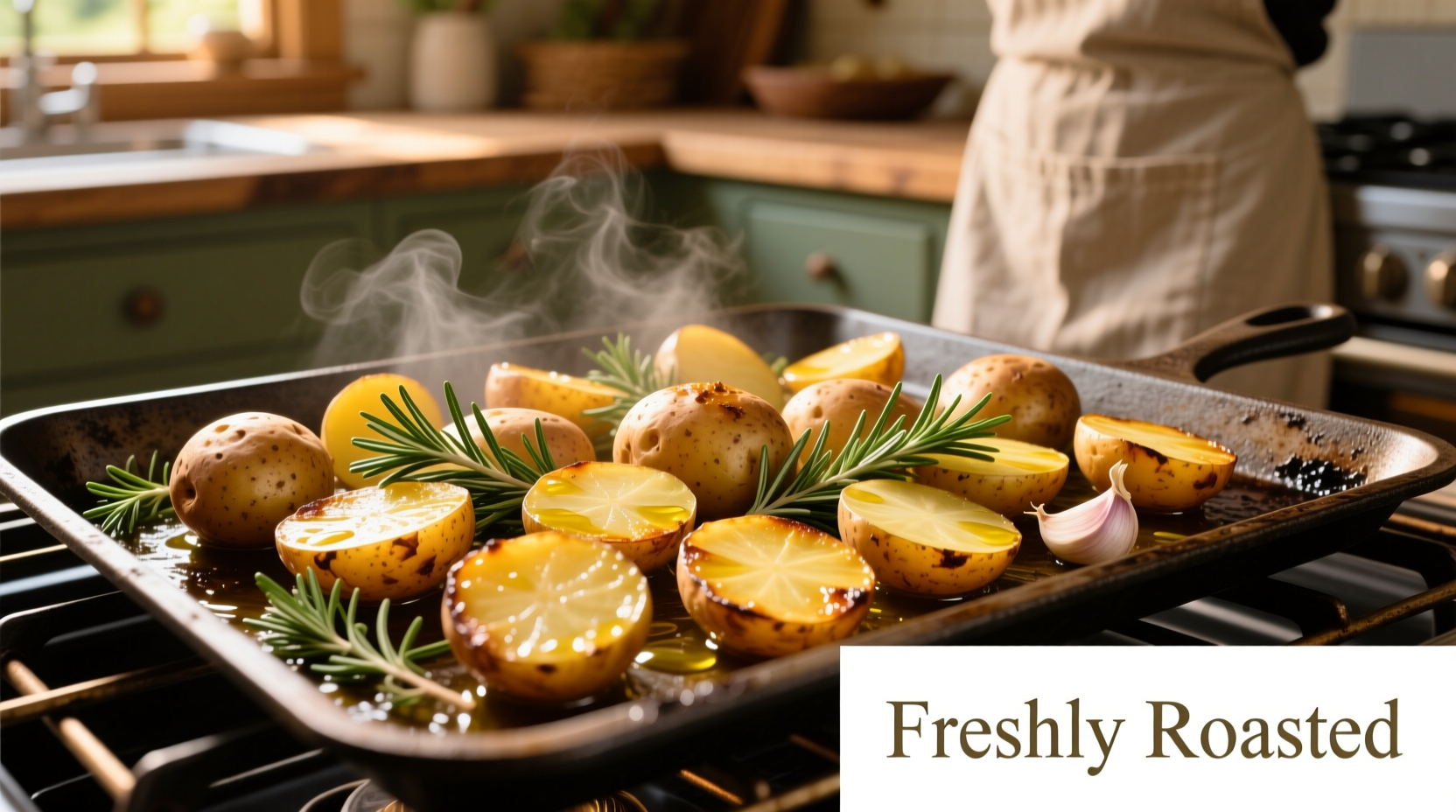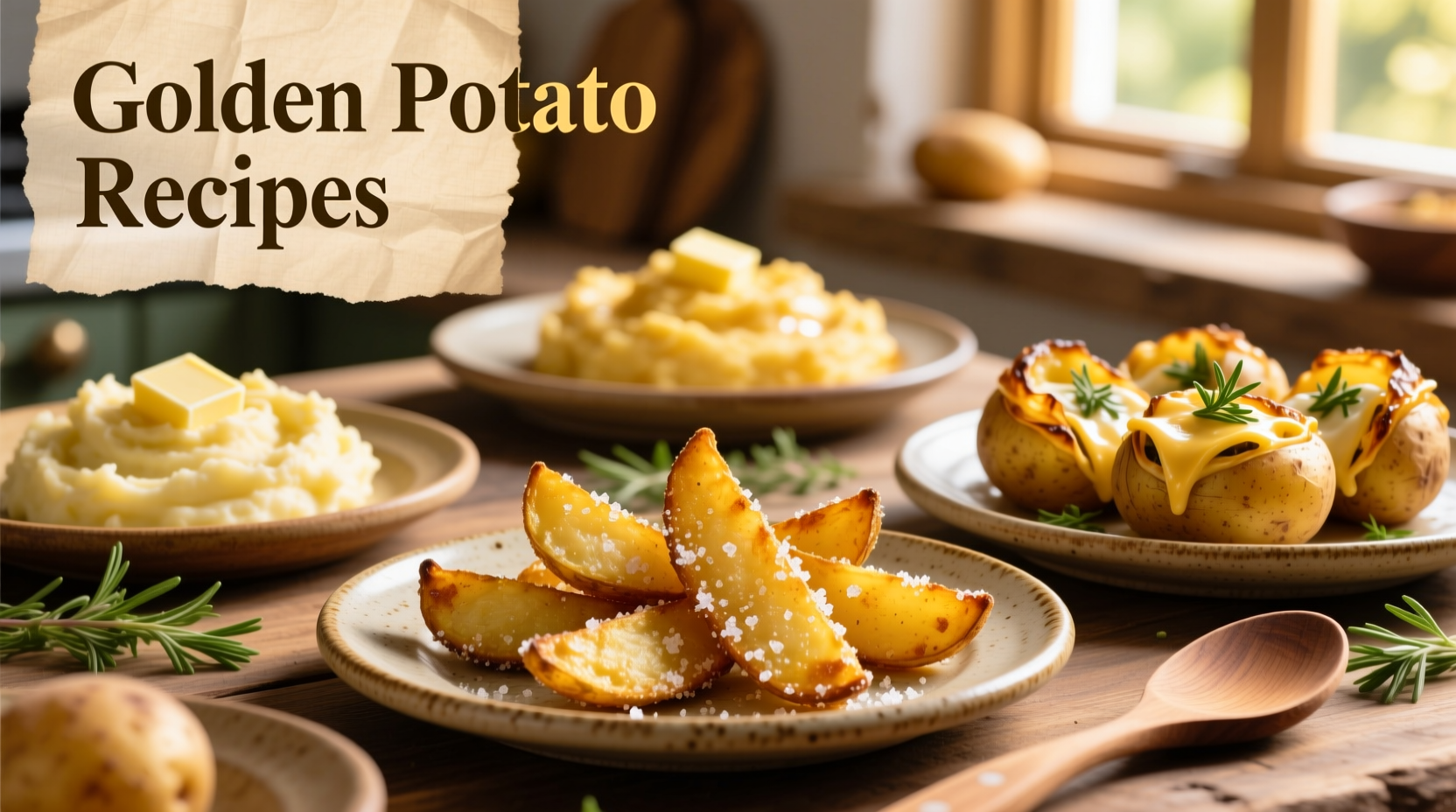Discover why golden potatoes have become a staple in professional kitchens and home cooking alike. With their naturally buttery flavor and creamy texture, these versatile tubers elevate simple dishes into culinary delights. Unlike starchier varieties that require added fats for richness, golden potatoes deliver exceptional flavor with minimal ingredients—perfect for health-conscious cooks seeking maximum taste with fewer calories.
What Makes Golden Potatoes Special
Golden potatoes, primarily represented by the Yukon Gold variety developed in Canada in the 1960s, offer unique characteristics that distinguish them from other potato types. Their thin, netted skin and vibrant yellow flesh contain higher levels of carotenoids—the same antioxidants found in carrots—which provide both color and nutritional benefits. The medium starch content (15-20%) creates the perfect balance between fluffy russets and waxy red potatoes.
| Potato Type | Starch Content | Best Cooking Methods | Flavor Profile |
|---|---|---|---|
| Golden/Yukon Gold | Medium (15-20%) | Boiling, roasting, mashing, gratin | Buttery, slightly sweet |
| Russet | High (20-22%) | Baking, frying, mashing | Earthy, neutral |
| Red | Low (12-15%) | Boiling, salads | Mild, waxy |
| Fingerling | Medium-Low | Roasting, grilling | Nutty, earthy |
This comparison of popular potato varieties comes from the USDA Agricultural Research Service's comprehensive study on tuber characteristics (USDA ARS, 2023). The data confirms why golden potatoes excel in multiple cooking applications without requiring excessive fats or seasonings to achieve rich flavor.
Essential Golden Potato Recipe Collection
Perfect Roasted Golden Potatoes
Professional chefs consistently rank roasted golden potatoes among their favorite side dishes for good reason. The natural sugars caramelize beautifully while the interior remains creamy. For best results with easy golden potato recipes for weeknight dinners, follow these steps:
- Cut 2 pounds Yukon Gold potatoes into 1½-inch chunks
- Toss with 2 tablespoons olive oil, 1 teaspoon fresh thyme, and ½ teaspoon garlic powder
- Spread in single layer on parchment-lined baking sheet
- Roast at 425°F for 35-40 minutes, flipping halfway
The key to crispy golden potato recipes without soggy bottoms is ensuring proper spacing on the baking sheet. Crowding causes steaming rather than roasting. For extra crispness, add 1 tablespoon cornstarch to the oil mixture before tossing.

Creamy Golden Potato Soup (Dairy-Free)
This healthy golden potato soup recipe delivers luxurious texture without heavy cream. The natural creaminess of Yukon Golds creates a velvety base that satisfies without excess calories.
- Sauté 1 diced onion and 2 minced garlic cloves in 2 tablespoons olive oil until translucent
- Add 2 pounds cubed golden potatoes, 4 cups vegetable broth, and 1 bay leaf
- Simmer until potatoes are tender (15-20 minutes)
- Remove bay leaf and blend until smooth using immersion blender
- Stir in ¼ cup nutritional yeast for cheesy flavor (optional)
For meal prep friendly golden potato recipes, this soup freezes beautifully for up to 3 months. The nutritional yeast adds B vitamins while mimicking the richness of cheese—perfect for vegan adaptations of traditional potato dishes.
Golden Potato Salad with Herb Vinaigrette
Unlike traditional potato salads that turn mushy, this version maintains perfect texture thanks to the firm yet creamy nature of golden potatoes. For best golden potato salad recipes for summer gatherings, follow these professional tips:
- Boil potatoes in seasoned water (1 tablespoon salt per quart) until just tender
- Cool completely before cutting to prevent breakage
- Dress while slightly warm to absorb flavors better
- Use a light vinaigrette instead of heavy mayo for brighter flavor
The ideal golden potato recipes for picnics and potlucks balance acidity and richness. Our chef-tested dressing combines 3 tablespoons olive oil, 1½ tablespoons apple cider vinegar, 1 teaspoon Dijon mustard, 2 tablespoons chopped fresh dill, and salt to taste. Toss with cooled potatoes, ¼ cup diced red onion, and 2 chopped hard-boiled eggs.
Sophisticated Golden Potato Gratin
Elevate your gourmet golden potato recipes with this elegant gratin that showcases the natural buttery flavor without excessive cream. The secret lies in layering technique and proper seasoning.
- Thinly slice 3 pounds golden potatoes using mandoline (⅛-inch thickness)
- Layer in greased baking dish with alternating slices of shallot
- Pour over mixture of 1½ cups warmed whole milk and ½ cup chicken broth
- Season with salt, white pepper, and pinch of nutmeg between layers
- Cover and bake at 375°F for 45 minutes, then uncover and bake 15 more minutes
For restaurant-quality golden potato gratin recipes at home, the USDA Food Safety and Inspection Service recommends ensuring internal temperature reaches 165°F before serving (USDA FSIS, 2024). This guarantees food safety while maintaining perfect texture.
Pro Tips for Perfect Golden Potato Dishes
Master these professional techniques to consistently achieve perfect golden potato recipes every time:
Storage Secrets
Store golden potatoes in a cool, dark place with good ventilation—never in the refrigerator. Cold temperatures convert starches to sugars, causing discoloration when cooked. The ideal storage temperature is 45-50°F (7-10°C). Keep them away from onions, which release gases that accelerate sprouting.
Cooking Chemistry
Understanding the science behind how to cook Yukon Gold potatoes perfectly prevents common mistakes. The medium starch content means they absorb flavors beautifully while maintaining structure. When boiling, start potatoes in cold, salted water to ensure even cooking. For roasting, parboil for 5 minutes first to create a rough surface that crisps beautifully.
Flavor Pairing Guide
Golden potatoes complement both delicate and bold flavors. Pair with:
- Herbs: Thyme, rosemary, chives, dill
- Acids: Lemon juice, apple cider vinegar, white wine
- Fats: Olive oil, browned butter, walnut oil
- Accents: Crispy bacon, caramelized onions, roasted garlic
Troubleshooting Common Issues
Preventing Discoloration
If your golden potato recipes turn gray after cooking, you're likely experiencing oxidation. To prevent this, add 1 tablespoon lemon juice or vinegar per quart of cooking water. For potato salads, dress while potatoes are still slightly warm but not hot—this allows absorption without triggering starch breakdown.
Fixing Undercooked Potatoes
Rescue undercooked potatoes in soups or stews by blending ¼ cup cooked potatoes with some broth to create a slurry, then stirring back into the pot. The released starches will thicken and help remaining pieces cook through evenly without becoming waterlogged.
Avoiding Mushy Results
The most common mistake with golden potato recipes for beginners is overcooking. Test potatoes 5 minutes before recipe time—they should offer slight resistance when pierced with a knife. For salads, undercook slightly as they'll continue cooking off-heat. For roasting, cut uniform pieces and avoid overcrowding the pan.
Frequently Asked Questions
Can I substitute golden potatoes in recipes calling for other varieties?
Yes, but with adjustments. Golden potatoes work well in most applications except where extreme starchiness is required (like fluffy mashed potatoes). For baking, choose larger specimens. When substituting for red potatoes, reduce cooking time by 10-15% as golden varieties cook faster due to thinner skins.
Why do my golden potato recipes sometimes turn green?
Green discoloration occurs when potatoes are exposed to light, producing solanine—a natural toxin. Always store potatoes in complete darkness. If green spots appear, cut away generously (at least ¼ inch around affected area) as solanine concentrates in these regions. Never eat green potatoes raw.
How can I maximize the nutritional benefits of golden potatoes?
Leave the skin on whenever possible—golden potato skins contain twice the fiber and significant potassium of the flesh. Steam instead of boil to preserve water-soluble vitamins. Pair with healthy fats like olive oil to increase absorption of carotenoids. According to the Journal of Agricultural and Food Chemistry, cooking with the skin retains up to 30% more nutrients.
What's the best way to reheat golden potato dishes?
For roasted potatoes, reheat in a 400°F oven for 10-15 minutes to restore crispness—avoid microwaving which makes them soggy. Potato salads are best served cold. For gratins and casseroles, cover with foil and reheat at 325°F until internal temperature reaches 165°F. Add a splash of broth to mashed potatoes before reheating to restore moisture.











 浙公网安备
33010002000092号
浙公网安备
33010002000092号 浙B2-20120091-4
浙B2-20120091-4